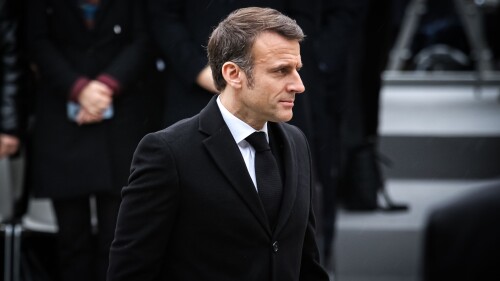To mark the first anniversary of the pogrom carried out by Hamas in the northwestern Negev (1,200 dead, 250 hostages—the largest attack against Jews since the Holocaust), Jean-Luc Mélenchon, the leader of the Far Left party “La France Insoumise” (Indomitable France) found nothing better than to call for flying the Palestinian colors. A final inversion of values, perfectly in line with his neo-Marxist, pro-Islamist, style. And the culmination of an unprecedented political marketing campaign focusing on the Palestinian Arab flag.
Three horizontal stripes—black, white, and green—overlaid with a red chevron near the hoist: thanks to Mélenchon and his kin, the Palestinian Arab banner is now omnipresent in France, as in many other Western countries. It loops endlessly on television and social media. It flies on the fronts of some town halls. It has replaced the red and black banners in left-wing protests and was even brandished by two Mélenchonist members of the National Assembly within the Parliament’s premises.
But every flag has a history. And the story of the Palestinian flag holds some surprises. In 2014, during a battle between Israel and Hamas, one of the Palestinian directors of the Middle East Monitor did not hesitate to question its legitimacy: “People who cherish it should remember that it was designed by the man who contributed more than anyone else to creating the State of Israel on Palestinian soil... the infamous Sir Mark Sykes, whose name remains tied to the 1916 Sykes-Picot Agreement, where France and England established ‘spheres of influence’ in an Arab world detached from the Ottoman Empire...”
Bedouin irregulars responded to a call to revolt by the Hashemite sheriff of Mecca and were advised by the British officer Colonel Thomas Edward Lawrence.
An “imperialist” or even “Zionist” flag? Perhaps. But that’s also the case for most of today’s Arab flags. They share the same origin: the “flag of the Arab revolt” raised in 1917 at Aqaba, in what is now southern Jordan. The same colors, and often the same overall design.
For nearly three years, the British Empire had been confronting the Ottoman Empire in the Middle East, which was allied with Germany and Austria-Hungary. The main front had long been in Mesopotamia: the British landed in Basra in late 1914, advanced to Baghdad, but were crushed by a Turkish counteroffensive at Kut a year later, in December 1915. Reorganized, they resumed their advance in 1916 and eventually captured Baghdad in March 1917.
A secondary front was between British-occupied Egypt and the Ottoman-ruled Levant. A Turkish force, led by German officers, managed to cross the Suez Canal in January 1915 but was quickly repelled. Neither side could overpower the other, and the battle line stabilized in northern Sinai, between El Arish and Nakhl, though raids and skirmishes continued.
In 1916, as they resumed their offensive in Mesopotamia, the British decided to do the same in the Levant, with troops from the UK, Pacific dominions, and India: the Egyptian Expeditionary Force, under General Edmund Allenby. Aviation played a significant role, for the first time in this region. But most operations, often in unbearable heat, relied on infantry, cavalry, camel-mounted troops, and heavy artillery. Allenby advanced to Rafah in January 1917 but failed at Gaza. However, in November 1917, he captured Beersheba, the capital of the Negev, opening the road to Jerusalem, where he entered, on foot and bareheaded, on December 11.
On the sidelines, Bedouin irregulars responded to a call to revolt by the Hashemite sheriff of Mecca, Hussein bin Ali, and were advised by a British officer who shared their life: Colonel Thomas Edward Lawrence. Their mission was to harass Ottoman troops and cut the Hejaz railway. They succeeded to varying degrees but made a name for themselves by storming the fortified port of Aqaba on the Red Sea, believed to be impregnable, on July 7, 1917.
The British sought to exploit this for propaganda purposes, as the war was changing. Since 1914, too many had died on all sides. A revolution had occurred in Russia. Mutinies were breaking out in other countries. America had joined the Allies, but on the condition that “freedom and justice” would prevail after the conflict. In this context, presenting ongoing operations in the Orient as a near-colonial conquest, or worse, a crusade against Islam, would be ill-advised. It was better to speak of a struggle for Arab independence and other nations enslaved by the Turks.
Anglo-Saxon journalists were on the ground, shaping this new narrative, dispatch by dispatch. Most of them were also photographers. One of them, American Lowell Thomas, who would later have a career in cinema, pointed out a flaw: “We can’t get anything out of these Arabs in terms of images. They have no uniforms, no flag. The public will wonder, seeing our photos, if these are not just mere bandits.” His advice: “First, a flag. An unusual shape. Highly recognizable.”
The British military command turned to Sir Mark Sykes. In his forties, this English Catholic aristocrat had traveled extensively throughout the pre-war Middle East and authored two successful books. He spoke Arabic, Turkish, and Persian. He had negotiated the secret 1916 agreements with the Frenchman Georges Picot. But contrary to the dark legend surrounding him today, he sincerely believed in the eventual emancipation of all Middle Eastern peoples: Arabs, Kurds, Armenians, and Jews.
The British military command turned to Sir Mark Sykes, an English Catholic aristocrat who had traveled extensively in the Middle East and spoke Arabic, Turkish, and Persian.
Sykes knew that the Middle East had never had national flags. Muslim rulers generally used a black, green, or red banner inscribed with a Quranic verse. There were two exceptions: Persia, where the Safavid dynasty in the 16th century flew its emblem, the lion and sun, on a green cloth, and the Ottomans, who adopted the red banner of Byzantium in 1453, adorned with a crescent moon and star. When Ottoman Egypt became a quasi-independent state in the 19th century, it only slightly modified the Sultan’s flag, replacing the red with green and giving the crescent three stars instead of one.
The “Arab national flag” had to be different from the Turkish flag—no red background, crescent, or star. What colors to use? Sykes chose those of the great Arab dynasties of early Islam: the white of the Umayyads, the black of the Abbasids, and the green of the Fatimids—colors sometimes adopted by Arab autonomists within the Ottoman Empire before World War I.
He imagined several designs and finally opted for three horizontal stripes—black, green, and white—with an uncommon element in vexillology: a bright red chevron, symbolizing the Hashemite dynasty, which could lead a “Great Arab Kingdom” under British influence. A few copies of this banner were distributed to the Bedouin troops, who displayed them every time they were photographed. One of them, acquired by the Australian Expeditionary Corps, is kept at the Melbourne War Memorial.
Immediately adopted by the Hashemite Kingdom of Hejaz in 1917, it became the flag of the short-lived Arab Kingdom of Syria proclaimed in Damascus in 1920, with the addition of a seven-pointed star on the green chevron. Later, the Hejaz and other Hashemite monarchies in Iraq and Transjordan rearranged the colors: black-white-green, with or without a star on the chevron. In this form, it became the quintessential Arab nationalist flag, even for republicans. Nasserite and Baathist regimes adopted it, with some modifications, from the 1950s onwards, as did Libya, Yemen, Sudan, and most Gulf countries.
And Palestine? Under the British Mandate, there was an official flag with the Union Jack in the canton, which no one used, and an unofficial blue and white flag representing the Jewish community (it was listed on the ‘Flags’ page of the Petit Larousse). By default, local Arab nationalists used the 1920 Hejaz flag, notably during the 1936 revolt. This usage was formalized by the Palestine Liberation Organization when it was founded in 1964.
It is strange, or telling, that the Palestinian movement never sought to modify this emblem, even in a very marginal way, to reflect a particular identity within the Arab or Islamic world. As if that identity didn’t really exist...
What would Sir Mark Sykes have thought? He likely had the wit to laugh at the tribulations of his flag. But the way so many extremists around the world, Palestinian Arab and otherwise, use it today would have shocked him. In December 1918, a few months before succumbing to the Spanish flu, he wrote to the Hashemite prince Faisal, the future “King of the Arabs” in Damascus and later King of Iraq in Baghdad: “Acknowledge the Jewish aspiration to live their national life in Palestine, and know how to make them powerful allies, rather than enemies.”








